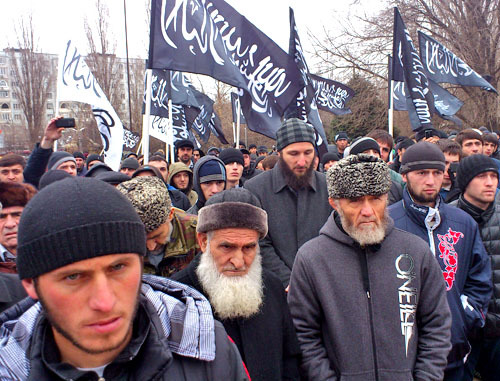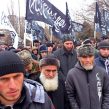
International Islamist Movement Spreads to the North Caucasus
Publication: Eurasia Daily Monitor Volume: 10 Issue: 93
By:

The Jamestown Foundation has repeatedly reported on Hizb ut-Tahrir’s (HuT) activities in Russia over the past several years. And as the investigation of the Boston bombings progresses, reports are surfacing in the West that Tamerlan Tsarnaev interacted with Magomed Kartashov, the leader of the Dagestan-based Union of the Just—essentially an offshoot of HuT (see Simon Shuster, Time.com, May 8). HuT is banned in Russia and has been driven underground, so Kartashov’s Union of the Just is nothing more than an offshoot of HuT with a new label. Due to the poor level of Western understanding about this group and its activities in Russia, Jamestown felt it appropriate to provide its readers with some background information should further details emerge about the links between Tsarnaev and this HuT offshoot.
Previous reports about the activities of Hizb-ut-Tahrir primarily focused on such regions of Russia as Tatarstan, Moscow and St. Petersburg (see EDM, November 20, 2012). However, this Islamic organization is active throughout most parts of the post-Soviet space, including Ukraine—especially in the Crimea—and the countries of Central Asia, including Kazakhstan (www.kavkazoved.info/news/2012/12/20/hizb-ut-tahrir-ot-kryma-do-kitaya.html). Now it has also started operating in the North Caucasus as well.
Hizb ut-Tahrir al-Islami (a.k.a. Party of Liberation) is an international organization that is banned in Russia. The Supreme Court of the Russian Federation designated HuT a terrorist organization and outlawed it on February 4, 2003. The organization is also on the list of banned organizations in the Commonwealth of Independent States (CIS) (www.cisatc.org/134/160/208).
Despite the ban, arrests of suspected HuT members in various parts of the Russian Federation are regularly reported. Reprisals against members of the party persist even though its program does not envisage taking any actions against Russia. According to Vitaly Ponomaryov, director of the human rights group Memorial’s program for monitoring human rights in Central Asia, the party was outlawed in Russia to appease Uzbekistani authorities because it is highly influential in Uzbekistan (https://muslimgauze.narod.ru/hizbut.html). An alternative explanation for the oppression of HuT in Russia is that it is considered to be under the control of Western security services, a claim made because the group operates freely in the United Kingdom (www.vesti.kg/index.php?option=com_k2&view=item&id=142). Arrests of party members in Russia do not go unnoticed among party members elsewhere in the world, who have called on Russia not to ban their movement (https://hizb.org.ua/ru/izdaniya/proklamacii/794-hizb-ut-tahrir.html). Demonstrations by Hizb ut-Tahrir’s members in front of the Russian Consulate in Simferopol, Ukraine, protesting the arrests of their colleagues, indicated that Russia had made yet another enemy (https://mail.volga-tv.ru/politika/Islamisty-iz-Khizb-ut-Takhrir-piketirovali-rossiyskoe-konsulstvo-v-Simferopole-FOTO-VIDEO-Konsul-vyrazil-vozmushchenie-passivnostyu-vlastey.html).
Hizb ut-Tahrir was long thought of as an organization that had no interest in the North Caucasus, instead being focused mostly on Tatarstan, Bashkortostan and the large Tatar diasporas in Moscow and St. Petersburg. The organization also worked among the ethnic Uzbek, Tajik and Kazakh diasporas concentrated in large Russian cities. It would be logically consistent to expect HuT to work among Turkic-speaking groups in the North Caucasus. However, an analysis of recent events shows that the organization does not rely solely on Turkic-speaking ethnicities.
In 2012, HuT was still not prepared to go public, and the North Caucasus public began talking about this Islamic group for the first time after a rally in the central square in Makhachkala, Dagestan, on February 8. Along with the Salafi organization the Association Ahlu al Sunna, there were also black banners identified at these rallies, and their bearers reportedly were party members of HuT. These banners were familiar to many people who knew about previous events in Tatarstan (https://xn--c1adwdmv.xn--p1ai/news/1625472.html). That was the organization’s first public exposure in the North Caucasus.
The second warning about Hizb ut-Tahrir’s expanding influence in the North Caucasus came from Ingushetia several months ago. On March 2, Ingush law enforcement agents detained four local residents on suspicion of being members of HuT. According to an Ingush interior ministry spokesperson, on February 29, police received a tip from local residents about a functioning HuT cell. The police confiscated a large amount of literature while detaining the suspects (www.interfax-russia.ru/South/news.asp?id=297361&sec=1672).
The movement received additional attention following an incident near the city of Kizlyar, Dagestan, when a wedding procession with black banners was stopped by the police and its participants were beaten up. The wedding procession, consisting of 25 cars, was dispersed by the police simply because they had “displayed extremist symbols” (https://kavpolit.com/imidzh-dagestana-i-xizb-ut-taxrir/).
Russian authorities have never charged any of the detained HuT members with participating in or sympathizing with terrorist activities. This is apparently not of concern to the Russian authorities. Indeed, even a conference in Kazan organized by the Russian Institute of Strategic Research (RISI) in 2012 could not coherently explain why the party should be considered a terrorist organization (www.riss.ru/index.php/actions/1328-fdjhl#.UY_ylzQqyKI). Conference participants spoke at length about the harmful nature of this organization, but did not cite a single instance of its involvement in terrorist activities. While regarding the idea of creating an Islamic state as a seditious plot, they could not explain why HuT members should be considered terrorists simply for believing in certain ideas.
Hizb ut-Tahrir’s appearance in the North Caucasus may cause yet another division among Muslims in the region. Even though the party calls for the creation of an Islamic Caliphate as its primary goal, it also recognizes the legitimacy of other Muslims. Most strikingly, as the organization strives to build a worldwide Caliphate, it does not ally itself with the jihadists anywhere in the world, including in the North Caucasus. Moreover, the armed resistance movement in the North Caucasus considers this party a sect that does not understand Islamic teaching (https://ummanews.com/opinions/9786-2013-01-28-22-57-23.html).
For the Russian authorities it would be much easier to have to deal with HuT than with militant jihadists. So it is plausible that the party’s emergence in the North Caucasus is not accidental. The Islamic party may become a political wing of the Islamists that will attract Salafi supporters.
At the moment, it appears that Hizb ut-Tahrir’s supporters are primarily concentrated in Kizlyar, in northern Dagestan. Since this movement is officially outlawed, its adherents operate under the guise of other organizations. The Union of the Just in Kizlyar, which is headed by Magomed Kartashov, represents Hizb ut-Tahrir. Kartashov is a relative of Tamerlan Tsarnaev, the slain Boston bombing suspect. However, the Union of the Just is not a Salafi organization. The Salafis do not recognize HuT, their ideology or their means of struggle. For the Salafis, it is simply a sect that has no right to exist (https://world.time.com/2013/05/08/exclusive-cousin-who-became-close-to-tamerlan-tsarnaev-in-dagestan-is-a-prominent-islamist/#ixzz2SlgzKDNN).
Thus, Hizb-ut-Tahrir is manifesting itself as a new player in the political arena of the North Caucasus. It will certainly make inroads into the support bases of other Islamic movements in the region due to the conservative culture of the local inhabitants, particularly in places like Dagestan. However, it is too early to say who will suffer most from the drain, the Sufis or the Salafis. It is plausible that Russian authorities could be behind HuT’s emergence in the North Caucasus, as the Russian special services likely could be secretly supporting these groups by simply allowing them to freely meet, operate and hold public rallies in the hope that it will undermine Salafist groups who stand to suffer the most from the defection of adherents. Since the bulk of the supporters of the regional resistance movements are made up of Salafist-leaning groups, the rise of another Islamic group like HuT stands to benefit Kremlin aims in splintering these groups. If the situation develops in an unexpected way, however, it could spin out of Moscow’s control once and for all—and much sooner than expected.
One thing is certain, as Western experts and journalists pay closer attention to the North Caucasus because of the Tsarnaev brothers, more and more details will emerge about these little-known groups in the North Caucasus like the Union of the Just led by Kartashov. Journalists and analysts should not rush to indiscriminately accept the interpretations by Kremlin-backed sources or certain Russian journalists regarding Hizb-ut-Tahrir or other such groups in the North Caucasus without first assessing the background, history and aims of these organizations in Russia. Most importantly, outside observers will need to discern whether sudden new revelations about a little-known group might not be part of a Kremlin-led information campaign aimed at convincing Western security services that Moscow is an indispensable ally in counter-terrorism cooperation. Accepting all such claims uncritically may force Western law enforcement and counter-terrorism experts to spend time and precious resources investigating groups that in reality have little influence in the tangled web of Islamic militancy in the North Caucasus.




